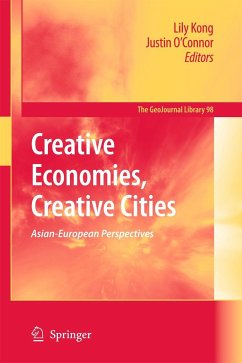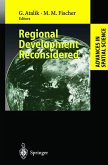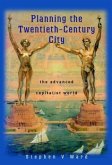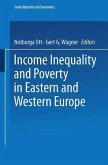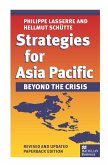The cultural and creative industries have become increasingly prominent on many policy agendas in recent years. Governments have identified the growing consumer potential for cultural/creative industry products in the home market, as well as for the growth of exports. The emphasis now lies on creativity, innovation, small business growth, and access to global markets - all in line with the move from cheap manufacture towards high value-added products and services. At the same time, the cultural and creative industries have become key drivers for urban regeneration and global repositioning of cities across Europe and Asia. Some of the themes, such as capital of culture, and attracting a 'creative class', have become global preoccupations. However, there are very real differences and ambiguities at play when such policy discourses move between historically distinct regions. By offering both Asian and European experiences, this volume shows the differences between them, and thus allows meaningful comparisons.
Justin O'Connor and Lily Kong The cultural and creative industries have become increasingly prominent in many policy agendas in recent years. Not only have governments identified the growing consumer potential for cultural/creative industry products in the home market, they have also seen the creative industry agenda as central to the growth of external m- kets. This agenda stresses creativity, innovation, small business growth, and access to global markets - all central to a wider agenda of moving from cheap manufacture towards high value-added products and services. The increasing importance of cultural and creative industries in national and city policy agendas is evident in Hong Kong, Singapore, Taiwan, South Korea, Beijing, Shanghai and Guangzhou, Australia, and New Zealand, and in more nascent ways in cities such as Chongqing and Wuhan. Much of the thinking in these cities/ countries has derived from the European and North American policy landscape. Policy debate in Europe and North America has been marked by ambiguities and tensions around the connections between cultural and economic policy which the creative industry agenda posits. These become more marked because the key dr- ers of the creative economy are the larger metropolitan areas, so that cultural and economic policy also then intersect with urban planning, policy and governance.
Justin O'Connor and Lily Kong The cultural and creative industries have become increasingly prominent in many policy agendas in recent years. Not only have governments identified the growing consumer potential for cultural/creative industry products in the home market, they have also seen the creative industry agenda as central to the growth of external m- kets. This agenda stresses creativity, innovation, small business growth, and access to global markets - all central to a wider agenda of moving from cheap manufacture towards high value-added products and services. The increasing importance of cultural and creative industries in national and city policy agendas is evident in Hong Kong, Singapore, Taiwan, South Korea, Beijing, Shanghai and Guangzhou, Australia, and New Zealand, and in more nascent ways in cities such as Chongqing and Wuhan. Much of the thinking in these cities/ countries has derived from the European and North American policy landscape. Policy debate in Europe and North America has been marked by ambiguities and tensions around the connections between cultural and economic policy which the creative industry agenda posits. These become more marked because the key dr- ers of the creative economy are the larger metropolitan areas, so that cultural and economic policy also then intersect with urban planning, policy and governance.
From the reviews:
"Creative Economies, Creative Cities, an edited collection of articles by academics from Europe, the Far East and Australia, puts Florida's thesis in global and historical context. The book mines a rich vein of debate that began long before 2002 about the effectiveness of the Creative Economy idea. ... The book is a kind of echo chamber for academics and policy-makers ... ." (Matthew J. Kiefer, ArchitectureBoston, September, 2009)
"One of the most valuable aspects of Creative Economies, Creative Cities is that it identifies questions from recent years about the cultural and creative industries, a sophisticated set of policy agendas regarding the development of creative economics and creative cities. ... This collection should be read by policymakers interested in design and implementation of culture-led regeneration projects." (Chang Bin Lee, International Journal of Cultural Policy, Vol. 17 (3), June, 2011)
"The book has a strong interdisciplinary approach-effectively reflecting the variety of topics and methods that characterise research in this area. ... the book proves a solid contribution and some of the chapters included will become highly cited within the field. ... it is the first attempt to adopt an inclusive view on the creative economy and give us a better understating of the creative economies discourses and creative city policies taking place in Asia. For this ground-breaking reason the book has to be praised." (Roberta Comunian, Journal of Cultural Economics, Vol. 34, February, 2010)
"Creative Economies, Creative Cities, an edited collection of articles by academics from Europe, the Far East and Australia, puts Florida's thesis in global and historical context. The book mines a rich vein of debate that began long before 2002 about the effectiveness of the Creative Economy idea. ... The book is a kind of echo chamber for academics and policy-makers ... ." (Matthew J. Kiefer, ArchitectureBoston, September, 2009)
"One of the most valuable aspects of Creative Economies, Creative Cities is that it identifies questions from recent years about the cultural and creative industries, a sophisticated set of policy agendas regarding the development of creative economics and creative cities. ... This collection should be read by policymakers interested in design and implementation of culture-led regeneration projects." (Chang Bin Lee, International Journal of Cultural Policy, Vol. 17 (3), June, 2011)
"The book has a strong interdisciplinary approach-effectively reflecting the variety of topics and methods that characterise research in this area. ... the book proves a solid contribution and some of the chapters included will become highly cited within the field. ... it is the first attempt to adopt an inclusive view on the creative economy and give us a better understating of the creative economies discourses and creative city policies taking place in Asia. For this ground-breaking reason the book has to be praised." (Roberta Comunian, Journal of Cultural Economics, Vol. 34, February, 2010)

